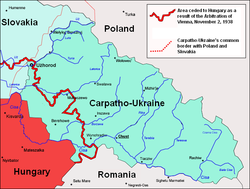Carpathian Ukraine
| Carpatho-Ukraine | ||||||||||
| Карпатська Україна Karpatska Ukrayina |
||||||||||
| Unrecognized state | ||||||||||
|
||||||||||
|
||||||||||
|
Motto "Ще не вмерла Україна" (Ukrainian) "Shche ne vmerla Ukraina" "Ukraine has not yet died" |
||||||||||
|
Anthem Ще не вмерла Україна (Ukrainian) Shche ne vmerla Ukraina Ukraine has not yet died |
||||||||||
|
Map of Carpatho-Ukraine in 1939.
|
||||||||||
| Capital | Khust | |||||||||
| Languages | Ukrainian | |||||||||
| Government | Republic | |||||||||
| President | Avgustyn Voloshyn | |||||||||
| Prime Minister | Julian Révaý | |||||||||
| Legislature | Soim | |||||||||
| Historical era | Interwar period | |||||||||
| • | Independence | March 14, 1939 | ||||||||
| • | Conquered | March 15, 1939 | ||||||||
| Area | 13,352 km² (5,155 sq mi) | |||||||||
|
||||||||||
| Today part of |
|
|||||||||
| Hungarian invasion of Carpatho-Ukraine | |||||||||
|---|---|---|---|---|---|---|---|---|---|
 Hungarian Border Guard Troops after execution of Sich members near Yasinia (March 1939) |
|||||||||
|
|||||||||
| Belligerents | |||||||||
|
|
|
||||||||
| Commanders and leaders | |||||||||
| Avgustyn Voloshyn |
Miklós Horthy András Littay |
||||||||
| Strength | |||||||||
| Carpathian Sich and OUN volunteers (2,000) | 40,000 | ||||||||
| Casualties and losses | |||||||||
|
Ukrainian military: killed, Ukrainian POW Ukrainian civilians: killed |
Hungarian military: killed, wounded Hungarian civilians: killed |
||||||||
Carpatho-Ukraine (Ukrainian: Карпа́тська Украї́на, Karpats’ka Ukrayina, pronounced [kɐrˈpɑtsʲkɐ ukrɐˈjinɐ]) was an autonomous region within Czechoslovakia from late 1938 to March 15, 1939. It was declared by Voloshin an independent republic on March 15, 1939. Voloshin named himself the president and asked Hitler to support him. Adolf Hitler did not reply and the historical part of Hungary was annexed by Hungary between March 15 and March 16, 1939, remaining under Hungarian control until the end of World War II, when it was ceded to the Soviet Union. The territory is now administered as Zakarpattia Oblast in Ukraine.
Soon after the implementation of the Munich Agreement of 29 September 1938 (by which Czechoslovakia lost much of its border region to Nazi Germany) Carpathian Ruthenia and Slovakia declared their autonomy within Czechoslovakia, which Prague accepted. The autonomous Carpathian Ruthenia (Subcarpathian Ruthenia 1919-38) changed its name to "Carpatho-Ukraine" soon afterwards, in November 1938.
In November 1938, under the First Vienna Award, which resulted from the Munich agreement, Nazi Germany and Italy prevailed on Czechoslovakia to cede the southern third of Slovakia and southern Carpatho-Ukraine to Hungary.
In late September 1938, Hungary had supported Nazi Germany by mobilizing between 200,000 and 350,000 men on the Slovak and Ukrainian borders, ready to invade Czechoslovakia in case of war between Germany and Czechoslovakia. After Munich the Hungarians had remained poised threateningly on the Slovak border. They reportedly had artillery ammunition for only 36 hours of operations, and were clearly engaged in a bluff, but it was a bluff the Germans had encouraged, and one that they would have been obliged to support militarily if the much larger, better trained and better equipped Czechoslovak Army chose to fight. The Czechoslovak army had built 2,000 small concrete emplacements along the border in places where rivers did not serve as natural obstacles.
...
Wikipedia



